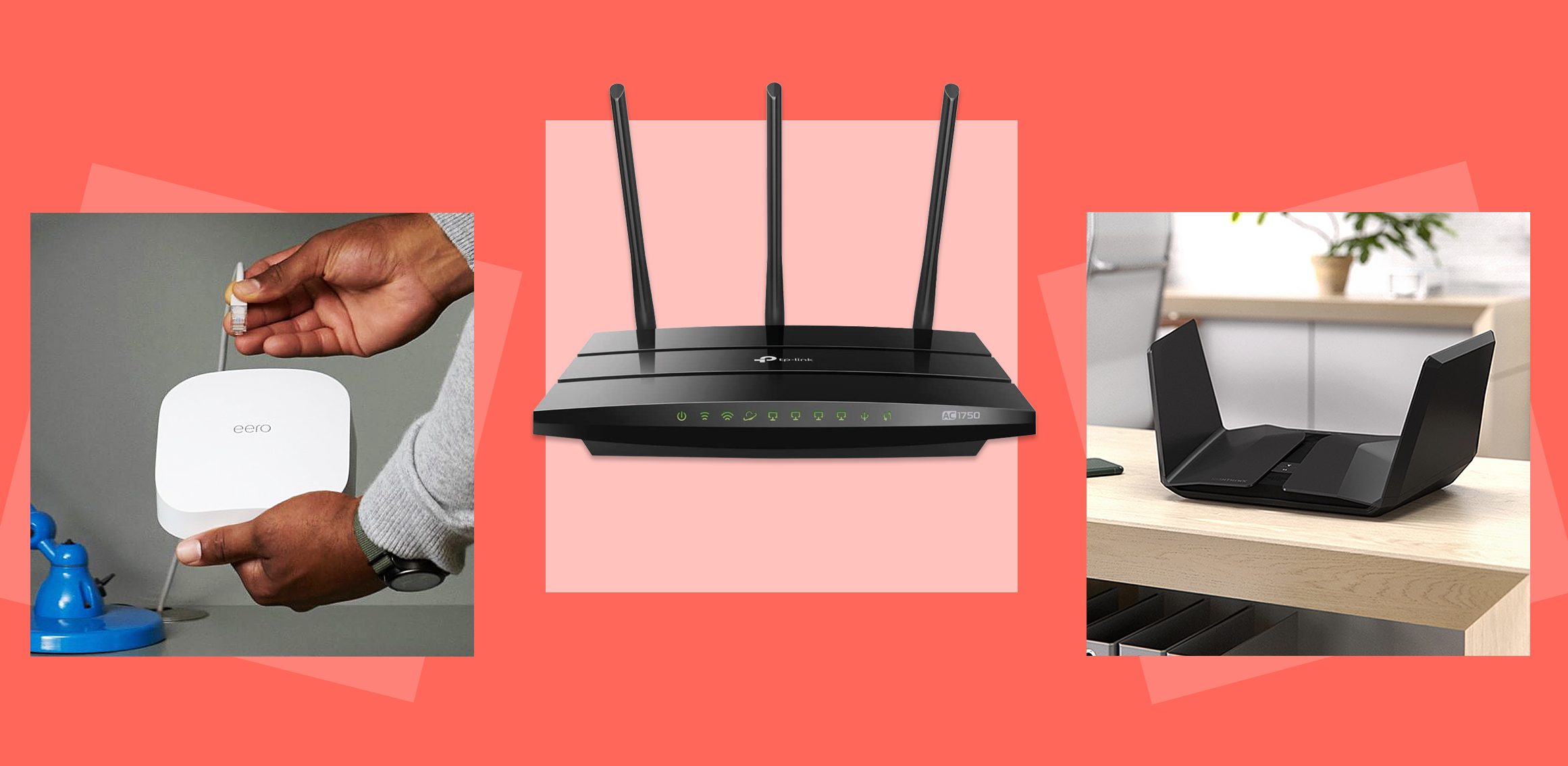Our fiber optic router for Internet service is known as one of the fastest internet services available and we make sure you will get the most out of your amazing connection. Is your router provided by your Internet provider okay? The equipment you receive from most internet service providers does nothing to improve your internet experience. Here is our list of the best router for fiber optic internet.
Compared to other internet connections, fiber optic internet is already quite expensive; investing a bit more in your internet connection can make all the difference. If you are a professional gamer then you understand how your Gameplay will improve with the “Best Gaming fiber optic internet router“.
How to choose the best fiber optic router
When shopping for the best fiber internet router, you will probably focus on compatibility. Nevertheless, there are a few other things you should consider as well, as follows.
-
Speed of the Internet
For fiber optic internet, your router should be capable of supporting and handling high speeds. Lag should be minimized to the maximum extent possible.
Faster internet speeds are associated with fiber internet. In other words, buying a slow router and combining it with high-speed fiber internet would be counterproductive.
-
Technologies used by routers
The router you use should have technologies like beamforming, MU-MIMO, and dynamic QoS to maximize performance. These routers provide a fast and reliable connection.
It is clear that fiber high-speed internet will benefit from these technologies, as they can broadcast the signal wide and ensure that all of your devices are connected to high-speed internet. These are just a few of the technologies that you will find in the routers above.
-
The number of devices
You need a router that supports the number of devices in your home. Because fiber-optic connections are fast, you need to have a router that supports the number of devices in your home. To support multiple devices, you should get a router that can handle multiple inputs.
The router needs to have some router performance technologies in order to connect to multiple devices in your house your antennas with high performance, CPUs with excellent performance, beamforming technology, QoS, and other technologies are among these logics.
Must check: Best Wireless Router For Apartment
In QoS, you can prioritize the connection so that devices that need high bandwidth are able toInstead of the signals being dispersed far and wide, beamforming allows your devices to receive good signals. As opposed to signals being dispersed widely. Good CPUs support simultaneous connections to multiple devices.
-
Range needed
High-speed internet will be available throughout your home through a good router. The range should be sufficient to allow your devices and home to be connected to the Internet. Ideally, a router should have high-gain antennas, Beamforming technology, and other features that increase range.
As you are choosing a fiber optic router for your home, you should ensure that it can provide high-speed internet to your entire house. Alternatively, if the connection does not improve, you may need to use Wi-Fi extenders to boost it.
-
Cost
The type of router you can buy depends on your budget. You should, however, research thoroughly to choose the best fiber router that matches your budget.
There are a few expensive routers for fiber internet. The bottom line is that regardless of the cost of your router, you will be able to enjoy your gaming, streaming, and other online activities.
Before checking the cost of a router, we recommend that you choose the right plan/tier for your needs. It is crucial to pick a router that will serve you in the future because routers last for a long time.
-
Routers that are dual-band or tri-band
Fiber optic internet connections require a dual-band router at the very least; a triband router is ideal. Fiber connections offer high speeds that a single-band router cannot provide.
The range and speed requirements will determine whether you need a dual-band or tri-band router. There is wide coverage with the 2.4GHz band, but it is prone to interference and slower than 5GHz. A 5GHz connection offers a faster speed, but a shorter range.
Because of this, both bands have a complementary range and speed.
-
Fiber-optic routers: Wi-Fi 5 vs Wi-Fi 6
We recommend that you use a Wi-Fi 5 or Wi-Fi 6 router for your fiber internet service. Internet connections through Wi-Fi 5 are fast. However, internet connections through Wi-Fi 6 are faster.
You may want to choose a Wi-Fi 6 router because it supports higher speeds, has better security protocols, and has more advanced features. Wi-Fi 6 is not supported by all devices.
Wi-Fi 5 (802.11ac) is compatible with a large number of devices, while Wi-Fi 4 (2.4 GHz) is not. Despite the fast speeds, the security features, and the ability to connect multiple devices, it does not meet the standards of Wi-Fi 6.
-
Ports over Ethernet
Due to their fast and reliable connections, Ethernet ports are important for gaming, high-definition streaming, and other internet-intensive activities. Thus, in order to take advantage of fiber internet’s high-speed, you require a router with Gigabit Ethernet ports.
To connect wired devices, you can select a router with one or more Ethernet ports (four, six, or eight). As a result, your wired devices will be able to enjoy reliable and high-speed connections.
Moreover, connecting some devices to the wireless network with an Ethernet cable reduces congestion. With this high-speed fiber connection, all devices can access the internet.
Which router is best to handle fiber optic?
After a lot of research, I’ve managed to gather the top 8 best fiber optic routers that you can use. In this article, I have written information about these routers with their pros and cons. Let’s check them out.
1- Netgear Orbi tri-band mesh Wi-Fi system – Best Fiber Optic Router
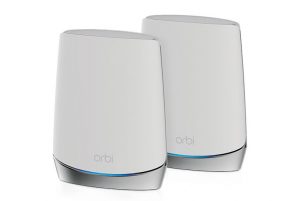
Netgear is among the bestselling brands among those looking for the best routers. Almost every review features a Netgear router, modem, or another networking device as a high-end product. When it comes to internet connections, this brand has proven to be excellent.
The beautiful shape and design make the Google fiber router model look great. You will be able to enjoy a connection for up to 20 devices within the range of 6000 square feet for the 3-piece unit. Using additional satellites, the wireless range of 2000 square feet can be extended to more devices and will offer a more comprehensive connection.
In addition, the router features a triband with a dedicated band’s backhaul, which ensures that the other bands will have maximum bandwidth. Thus, you achieve high speed for all your devices with a remarkable elimination of dead zones.
Must check: Best router for cox cable
With wired Ethernet and gigabit ports, it provides high-speed transmission. You will be using the Ethernet ports, which are capable of 22 Gbps, ideal for streaming, gaming, and fast downloads. Surfing gets faster with the Ethernet ports.
[i2pc show_title=”true” title=”Pros & Cons” show_button=”false” pros_title=”Pros” cons_title=”Cons” ][i2pros]Internet speed is excellent
Beautiful design
Throughput that is fast
Connections that are stable
A wide range of options
Extending the internet is simple
Supports MU-MIMO for multiple devices
Backhaul using the 5GHz spectrum
Setup is simple
[/i2pros][i2cons]The USB functionality is limited
This mesh system is bulkier than others
[/i2cons][/i2pc]
2- Google Nest Wi-Fi AC2200 Wi-Fi Router – Best to Handle Fiber Optic
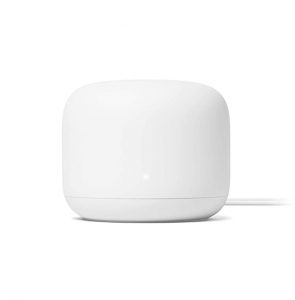
One of the best Fiber optic routers you can find is undoubtedly the stylish, cutting-edge, and sturdy Google Nest Wi-Fi router. A modern aluminum shell neatly houses the compact device, which features Mesh technology that creates a smart home network. Up to 2,200 square feet can be covered by the router. ft. while eliminating any lags or buffering so your family can stay connected wherever they are.
A 15W power adapter is included with Google’s Nest Wi-Fi, and it is easy to set up. Automatic updates ensure you have access to all new features and your network remains secure. While it lacks USB ports, the device offers Ethernet ports and supports speeds up to 2.2 Gbps. A maximum of 200 devices can be connected at once – even when streaming 4K videos. In addition, this makes for a scalable and flexible Wi-Fi system, which can support more access points for better coverage.
Must check: Router for Chromecast Streaming
In addition to creating a guest network and sharing the password, users can choose which connected devices are prioritized for faster speeds using the Google Nest Wi-Fi router. To manage your child’s online time, you can also implement Parental Controls.
[i2pc show_title=”true” title=”Pros & Cons” show_button=”false” pros_title=”Pros” cons_title=”Cons” ][i2pros]Tests show solid performance in terms of throughput.
Design with style.
Installation is simple.
Google Assistant built-in.
[/i2pros][i2cons]Backhaul band is not dedicated.
You don’t have any anti-malware tools.
Separate apps are required for advanced settings.
There are no USB ports.
[/i2cons][/i2pc]
3- TP-Link Archer C7 AC1750
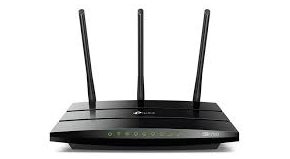
The Archer C7 from TP-Link may be the perfect option for you if you want an exceptional router that does a lot. The router has three external Wi-Fi antennae, in addition to three internal ones. The six antennae make for extended coverage around the house, making it one of the best wireless internet routers. External antennas can be easily moved. So, you can direct the wireless signal towards areas of the house that suffer from dead zones.
Wi-Fi 5 is the Wi-Fi standard for TP-Link devices, i.e. 802.11ac. 2.4GHz & 5GHz bands support 450 Mbps & 1300 Mbps, respectively. It supports up to 1.75 Gbps combined speed and dual-band technology. 2.4GHz can handle lighter tasks like emailing and browsing, while 5GHz can handle bandwidth-intensive tasks like online gaming and HD video streaming—all at the same time.
In addition to a USB 2.0 port, the Archer C7 offers versatile functionality for accessing and sharing media files via your home network. Additionally, it has a Gigabit WAN port and four LAN ports. The Archer C7 gives you ten times the speed of an Ethernet connection and lets you connect up to four devices simultaneously.
By using the TP-Link Tether app, you can manage your Wi-Fi network as well as set up the TP-Link Archer with an easy-to-use graphic interface. With the powerful processor, you can balance all demands seamlessly, and this includes gaming online, streaming HD, downloading and sharing media.
In addition, you will receive 24/7 tech support and the device comes with a 2-year warranty.
[i2pc show_title=”true” title=”Pros & Cons” show_button=”false” pros_title=”Pros” cons_title=”Cons” ][i2pros]The price is reasonable.
Throughput is very fast.
Installation is simple.
Management settings abound.
[/i2pros][i2cons]Unintuitive user interface.
File transfers are sluggish.
There are only USB 2.0 ports.
[/i2cons][/i2pc]
4- D-Link AC2600 MU-MIMO
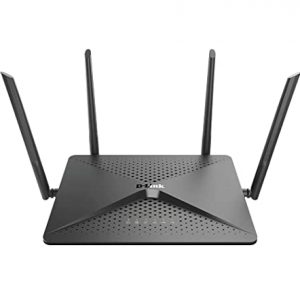
Connectivity inside your home has never been easier with the D-Link AC2600! You can connect wireless and wired devices to the internet with ease thanks to its dual-core processor. As this dual-band device runs the Wi-Fi 5 standard, which is 802.11ac, it can support combined speeds of up to 2600 Mbps – the 2.4GHz band can handle 800 Mbps and the 5GHz band can handle up to 1733 Mbps.
MU-MIMO technology, together with the advanced AC SmartBeam, allows you to enjoy smooth online gaming and HD/4K video streaming on multiple devices. In combination with support for four simultaneous data streams and intelligent QoS technology, this remarkable device ensures a superior Wi-Fi experience while you move around the house.
There are built-in USB 2.0 and 3.0 ports on the D-Link AC2600 that are ideal for media sharing, charging the router’s battery, and transferring firmware updates. Additionally, the device is equipped with 4 Gigabit Ethernet LAN ports and 1 Gigabit Ethernet WAN port.
[i2pc show_title=”true” title=”Pros & Cons” show_button=”false” pros_title=”Pros” cons_title=”Cons” ][i2pros]Testing shows good close-range throughput.
Good quality of service engine.
Installs easily.
[/i2pros][i2cons]File-transfer speeds and throughput are medium at 5GHz.
Malware protection is not built-in.
Parental controls are limited.
[/i2cons][/i2pc]
5- NETGEAR R6330 AC1600
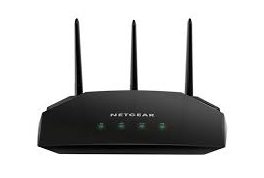
With several advanced features, the Netgear R6330 router is an excellent choice for both home and business use. With its dual bands and 880MHz processor, this device offers a combined speed of 1.6 Gbps through its dual bands.
Up to 1200 square feet of coverage is provided by this Netgear device. MU-MIMO integrated technology allows up to 20 devices to stream simultaneously in a 10,000-square-foot facility. Advanced QoS technology and powerful external antennas further enhance your Wi-Fi experience.
In addition to the USB 2.0 port, the four Gigabit Ethernet ports provide super-fast wired connectivity for computers, gaming consoles and streaming devices.
A high-level firewall is included as well as WPA/WPA2 wireless security for your network. You can also create a guest network, which will be separate from your private network at home.
It is very easy to set up the router using the Nighthawk® app, and you can even make the most of your Wi-Fi network right from your smartphone.
[i2pc show_title=”true” title=”Pros & Cons” show_button=”false” pros_title=”Pros” cons_title=”Cons” ][i2pros]Setup is easy.
Connects to a wide range of devices.
A very good security system.
A powerful parental control system.
[/i2pros][i2cons]Config options are limited.
Coverage and speed are average.
[/i2cons][/i2pc]
6- TP-Link Archer C9 AC1900
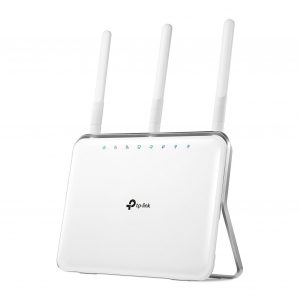
The Archer C9 AC1900 from one of the most authentic brands in the market enhances your home WiFi while being elegant in design. The device is powered by a 1GHz dual-core processor, which handles the demands of all connected devices efficiently and balances the demands of the entire smart home device cluster. The router is based on the Wi-Fi 5 standard – 802.11ac – and its 5GHz and 2.4GHz bands can support combined speeds of up to 1900 Mbps. So, you can stream 4K content and play online games on multiple devices simultaneously using Wi-Fi.
Combined with three detachable dual-band external antennas, the beamforming technology enables the router to identify connected devices and focus the Wi-Fi signal on them instead of sending it out in all directions.
TP-Link fiber routers are equipped with dual USB ports-one USB 3.0 and one USB 2.0. The faster USB 3.0 port supports external devices and is far faster than a USB 2.0 port. which way, you can share media with ease over your home network. Moreover also comes with 4 Gigabit LAN ports, making it a perfect gaming router-not to mention its 1 Gigabit WAN port.
The user-friendly interface of this fiber router is one of the main reasons for its popularity. The TP-Link product is also covered by a 2-year warranty, so you can receive 24/7 tech support during that time.
[i2pc show_title=”true” title=”Pros & Cons” show_button=”false” pros_title=”Pros” cons_title=”Cons” ][i2pros]The TP-Link Tether app is used to control and manage the network.
Throughout the day, you can contact us.
There are two USB 2.0 ports and one USB 3.0 port.
Technology for beamforming.
The sharing process is simple.
Support for IPv6.
Control by parents.
A tethering app.
[/i2pros][i2cons]It does not have eSATA ports.
Occasionally, there is a speed issue.
2.4GHz bands are buggy.
A setup issue has occurred.
[/i2cons][/i2pc]
7- NETGEAR Nighthawk X6S AC4000 – Best Router for Streaming with Fiber Optic
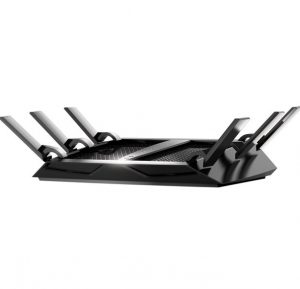
As its name suggests, the Netgear AC4000 tri-band router offers three Wi-Fi bands. Using the third band, you can communicate between the router and satellite with less network congestion and less device interference, resulting in faster and better performance. Based on a dual-core processor running at 1.8 GHz, the router has a combined speed of 4 Gigabit-per-second bandwidth-meets the demands of 4K/UHD streaming and competitive gaming online.
Up to 3500 square feet can be covered by the 6 powerful antennae. With the Beamforming and MU-MIMO technologies, every part of the house is covered by a reliable wireless signal. There’s no limit to how many users and smart devices you can connect – the Netgear fiber router supports up to 55 devices. In addition, the unit comes with two USB 2.0 ports and one USB 3.0 port, so you will be able to share storage drives or printers with any connected device. You can connect gaming consoles, streaming devices, laptops, etc. to the four 1 Gigabit Ethernet ports for wired high-speed Internet.
In addition to WPA2 security protocols, the Nighthawk X6S includes a guest network option, firewall protection, and VPN capabilities. As an additional bonus, you get a 30-day free trial of Netgear Armor powered by BitDefender, leading security software that protects your connected devices from cyber threats. It’s also worth mentioning the Circle app, which lets you manage internet access and mobile screen time with smart parental controls at your fingertips.
[i2pc show_title=”true” title=”Pros & Cons” show_button=”false” pros_title=”Pros” cons_title=”Cons” ][i2pros]Installation is simple.
There are many settings to choose from.
Testing is performed at a good rate.
[/i2pros][i2cons]It is expensive.
The performance of file transfers is average.
[/i2cons][/i2pc]
8- TP-Link AX6000 Wi-Fi 6 Router
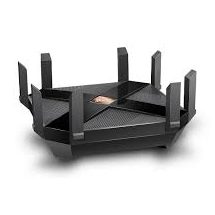
A perfect choice for fiber optical internet, the TP-Link AX6000 features the latest wireless technology and excellent compatibility. You will get high speeds for your wired devices with the router’s 8-gigabit ports.
Design and aesthetics are not the only impressive features of this router. The speeds are also impressive. The router offers dual-band data speeds of 4804 Mbps and 1148 Mbps with significant 1024QAM enhancements. It will give you optimum performance on all of your devices.
Must check: Best router Wirecutter
OFDMA is able to boost speeds four times in situations of high density so that more devices can be properly supported. Its superior performance makes the router a better choice than the 802.11ac.
Further, this router model has eight antennas with powerful features that make it possible for a larger range of internet access. By using BSS technology, the interference of the signal gets reduced, which also makes the internet more stable.
[i2pc show_title=”true” title=”Pros & Cons” show_button=”false” pros_title=”Pros” cons_title=”Cons” ][i2pros]High-speed internet
High compatibility
The technology used in WiFi 6
The LAN port number is 8
Provides support for link aggregation
A very safe application with parental controls that can be individually adjusted for each child
TP-Link Tether app or web console makes configuration easy
Excellent performance technologies including Beamforming and Quality of Service
One USB 3.0 port and one USB C port are available on the router
[/i2pros][i2cons]Dual-band connection as opposed to triband
The antennas cannot be changed or aimed
I am unable to find an idle mode for the router
[/i2cons][/i2pc]
How do modems and routers differ?
Obviously, a router and a modem are two different devices. Modems are devices that let you connect directly to the internet. Upon receiving internet signals, it decodes them and sends them to the router, which then sends them to your laptop, smartphone, and other devices connected to your network wirelessly.
An optical network terminal (ONT) is actually what the modem is known as when it comes to fiber-optic internet. An ONT converts fiber signals into Ethernet signals that can be delivered to routers via Ethernet cables since fiber cables can’t connect directly to routers.
In the case of fiber optic internet, the ONT is usually installed by your provider and is not a device that is widely available to consumers. A fiber optic cable (such as Cat 6a) can be used to connect the router to a computer via Ethernet. Many providers charge a monthly fee for supplying customers with rented routers, so owning your own router could also save you money.
When combined with an appropriate router, fiber optic internet can really make a difference. When multiple people use the connection at the same time, it can provide faster download speeds even when you’re several rooms away from the router. Streaming 4K movies in one room while someone is playing online games in another room is very simple, and there will be no lag between them.
About Fiber optic plan
Regardless of what plan you choose, your connection will only be as fast as the plan you choose. So even if your router is fast, if your plan provides a maximum of 500 megabits per second (Mbps) of bandwidth (the maximum amount of data you can send at one time), your connection will not reach gigabit (Gbps) speeds.
Keeping in mind that wireless signals can be weakened by walls between you and your router as well as interference from other connected devices, it is important to keep that in mind. Connecting devices directly to the Ethernet ports of your router is the only way to get speeds close to what your ISP advertises.
Additionally, devices with older Wi-Fi technologies slow down speeds. Even with one of the latest routers on the market, a laptop from 2012 won’t magically perform at top speed.
What are the benefits of Fiber-Optic Internet?
The world is currently dominated by fiber optic internet. As a result, the internet can now be accessed at higher speeds than ever before, especially in areas without cable or DSL service. In addition, over 19 million Americans now use fiber-based internet technology and the number is rising rapidly. Among its advantages are the following:
1. High-speed Internet:
The fastest internet connection speed is 1 Gbps, which is typical for fiber optic internet. It will be possible to play games or stream 4K videos without any delays and have plenty of bandwidth for several devices at the same time! The price starts at $40/month, which is a bargain for the speed!
It will be as if we were able to have an entirely new set of Wi-Fi capabilities 24/7 without ever having to leave behind one Resolution anymore, thanks to fiber optic technology.
2. Speeds equal for uploads and downloads – unlike cable, satellite or DSL
There is no comparison between fiber optic internet connections and traditional cable, satellite, or DSL connections in terms of upload and download speeds. With this type of connection, you don’t have to wait for uploads since you get identical speeds for downloading and uploading!
In addition, service providers will be able to cater more to providing reliable access to files over the internet while still being able to share them over the internet with no problems at all. In this way, ISPs can upload as well as download files without overtaxing their systems.
Having this kind of connection also means we’ll be able to work remotely from our office while still easily sharing documents at home.
3. Increased reliability
In addition to greater reliability and reduced packet loss, fiber internet has many other benefits. Besides being faster and more reliable than cable, fiber internet is also more affordable. A fiber-optic connection allows users to share data at much higher speeds. Cable networks don’t need energized lines, so this is not a problem. As a result, the network will continue to work even when the power is out.
Thus, fiber optic connections can deliver data at higher speeds without packet loss or interruption for an entire neighborhood, as opposed to the cumbersome copper cables commonly found in houses today.
4. No delays during peak hours
During peak hours, there is congestion with cable and DSL connections. In the early evenings when everyone is on the internet, you will find that most homes complain about poor internet connections.
Fiber optic internet connections do not have that problem. Fiber optic cables can transmit information regardless of the time of day or night, so there are no interruptions along the way like delays due to interruptions from either side.
5. Multiple devices can be used simultaneously
A fiber optic internet connection allows for multi-device connectivity in the future. For the futuristic internet to work on your premises, you will have to purchase a fiber optic router.
Streaming devices, gaming machines, tablets, and laptops can all be connected at the same time to fiber optic internet without experiencing signal dropouts! There is plenty of room for every music video streamer as well, since there is ten times the bandwidth as regular access.
No matter what you want to accomplish, the newest technology will make sure that you don’t miss out. It is the same regardless of whether another user is on voice chat over Skype; another might be in a hurry during an online battle and not want to wait around until someone completes typing.
6. Internet via fiber optics is more secure
Fiber-optic connections are more secure: Fiber-optic communication offers the highest level of security due to the way in which information is transmitted.
Communicating securely is essential. Due to fiber optics’ ability to encrypt data, hackers or others with malicious intent can’t intercept signals traveling almost at light speed through space and time!
7. Transmission distances are longer
In comparison to DSL and cable internet, fiber internet offers a longer transmission distance. With minimal power loss, light waves transmit through glass.
The transmission of signals over these types of media has an issue with traditional networks powered by metal cables (DSL and cable connections). During transmission, metal cables tend to lose power.
Using metals for data transmission is not very efficient since most if not all of the data is lost as it moves from point A to point B. The reason for this is that electromagnetic interference can interfere with performance, affecting things like signal reception or distortion caused by metals.
On the other hand, fiber has been designed specifically to address these issues, so it can transmit data over greater distances. There is only one cause for signal loss with fibers, and that is faulty installations that result in a minimal loss in connection length due to improper manufactures, a reflection of light, or breaks in the connection line.
8. Data can be transferred using analog or digital signals
As a data transfer medium, fiber can use both analog and digital signals. A difference between this and DSL or cable internet is that there is no modulation or demodulation needed. Because DSL and cable connections only transmit analog signals, conversion to digital must be done before your access can be made.
9. Reduction of electromagnetic interference
Data transmission is required for DSL and cable connections. EMF interferes with the transmission and causes noise.
Light is used to transmit data, so there is only a minimal amount of interference from electrical signals. This makes fibers relatively noise-free. Furthermore, the fiber-optic internet cables are generally shielded from lightning strikes for the same reason.
10. Fiber optic cables are smaller than copper cables
The diameter of fiber-optic cables is smaller. Since they don’t consume much space, they can be used almost anywhere. Copper cables, on the other hand, consume a lot more space.
As a result, fiber optic cables can be easily installed in every household.
Best Fiber Optic Router FAQ’s
What is the speed of fiber internet?
Currently, the fastest internet we have is fiber internet from most ISPs. Because fiber connections use “cladded” glass cables for internet transmission, they are extremely efficient. As compared to electric signals in cable or DSL internet, fiber transmits signals using fast pulses of light. As a result, most ISPs offer plans with speeds up to 10Gbps. The speed of download and upload is very fast with these speeds. Fiber internet is also much faster than DSL or cable connections, both in terms of download and upload speeds.
What are the providers of fiber internet in the US?
Compared to readily available cable and DSL internet infrastructure, fiber internet provision is quite expensive in the initial planning stages. For this reason, fiber internet is only available in certain parts of the country. Fiber-to-the-node technology allows DSL or cable internet providers to increase the speed of their connections. There are several companies that offer residential fiber internet in the US, including Cox, Century Link, Frontier, Verizon, Mediacom, Suddenlink, Google, and Windstream. AT&T and Verizon are currently the two most extensive fiber providers.
With fiber-optic Internet, do you need a modem?
Fiber optic internet does not require a modem. Fiber optic internet does not use cables or phone lines. You will receive an ONT box near your home from your ISP. In order to transmit the internet in your home, the ONT box is connected to a router.
The fiber optic connections are however provided by some ISPs using a gateway and modem combo. The connection will be made without the need for a separate modem.
Which fiber connections are available?
Fiber optics make up three of our main internet connections. These are:
- Fibre To The Home (FTTH) or Fiber To The Premises (FTTP):
Fiber optic cables run to your home or office in this internet connection. As opposed to the two below, the ISP provides fiber-optic cables up to your home/premises.
- Fiber-to-the-curb (FTTC):
A fundamental difference between FTTH/FTTP is that fiber cables are not run into your home or business; instead, they terminate just outside. Your ISP then connects your home or premise via a cable connection.
- Fibre To The Node or Neighborhood (FTTN):
ISPs commonly use this type of fiber connection. There is no fiber optic cable that reaches your home or curb, but a central hub in your neighborhood. To connect to your premises/home, the ISP uses either a DSL or Cable connection from the central hub.
What does a fiber optic router do?
Glass fibers are used in fiber optic routers to transmit signals over long distances at lightning speed without altering their quality or quantity. Due to the fact that they are not affected by distance, optical transmissions can travel further than radio waves. Because of its incredible clarity, optical signals are preserved perfectly along the way.
Internet routers using fiber optics are a really cool technology. You can now transfer data at high speeds with these devices using light waves instead of electrical wires! A fiber-ready router or residential gateway will be needed to ensure that you can take advantage of fiber-optic speeds. By providing your home with Internet access at lightning speed, fiber routers give you an edge over other homes
Bottom Line
If you invest a little in your home network, you will be amazed at what a difference it can make to your everyday experience online. Be sure to know what to look for before you purchase a router to upgrade or extend your home network.
Although we have reviewed the characteristics of the top fiber routers in the market, remember that reliable and fast internet can only be obtained by selecting a reputable fiber internet provider first. If that is not the case, upgrading or extending your home Wi-Fi network will not solve the problem. We advise you to choose a router that matches your needs regardless of whether your budget is limited or you are willing to spend the extra money.

